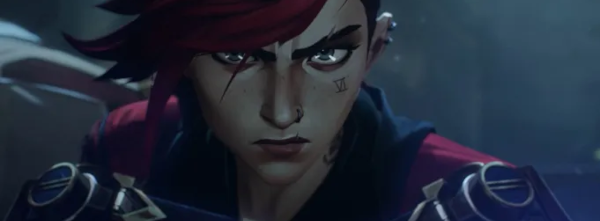
Arcane is an animated fantasy series released on Netflix and based on a computer game called League of Legends. This is definitely not something I would normally seek out but I heard (or read) that the series was very good. Well, thank goodness I decided to check it out because it is extremely good. In fact, I was quite astonished at how good it was.
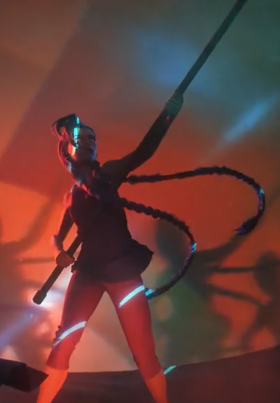
The actual production was done by Riot Games and the French company Fortiche (careful on that site: full-on video playback). It was actually increasingly clear that there was a high French/European component to the show just by looking at it: I have a high regard for the French way of art and animation, particularly imaginative fantasy work like this.
So, I cannot recommend this highly enough: it is like a gritty, violent and stylish steam-punk comic strip mixed with a music video. Just beautifully put together with next to nothing left in an "uncanny valley" or clunky in any way.
As important as the style and animation, probably even more so, is the characterisation and storyline. And here too, the show works wonderfully: so well that you end up not only caring about people but even moved on occasion.
This type of series does not come along very often and it is easy to feel somewhat depressed at the state of film or video entertainment, especially since Marvel/Disney, DC and Amazon have imploded their quality so much recently. Arcane definitely raises the spirits.
I am not the only one who rates this so high: Arcane has won many awards, including the Emmy. Lots of people love it.
Dovecot Studios in Edinburgh have a great exhibition on at the moment called The Scottish Colourists: Radical Perspectives. It covers a bit more than just the Colourists, including other artists working around the same time, such as: Sargent, Whistler, Melville (a great watercolour on display) and some of the Bloomsbury Artists, such as Duncan Grant.
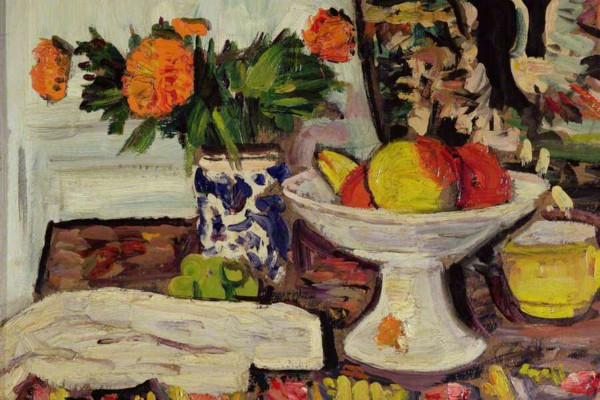
Above: Leslie Hunter, Peonies in a Chinese Vase, 1925,oil on board (from Dovecot web site)
Perhaps it is a little easy to forget Dovecot Studios sometimes, unless you keep an eye on weaving and tapestry arts, but it is a bit more than a tapestry studio. It does a lot of art, craft, design and education as well and has a really good exhibition space. There were a lot more paintings being shown than I expected, which was a very pleasant surprise.
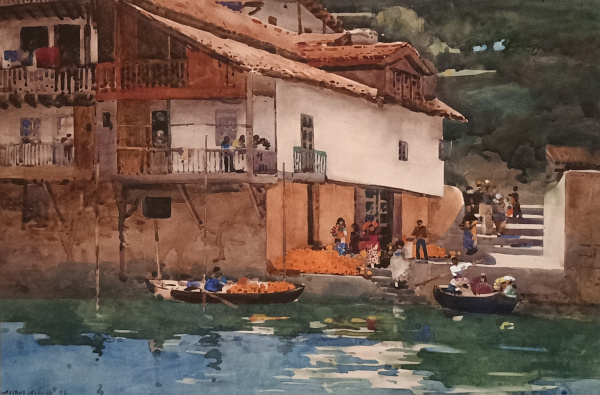
Above: Arthur Melville, Orange Market, Puerto de Los Pasajes, watercolour on paper, 1892
I was surprised and happy to see a painting by Kees Van Dongen :

Above: Kees Van Dongen, A Vase of Flowers, oil on canvas, 1920
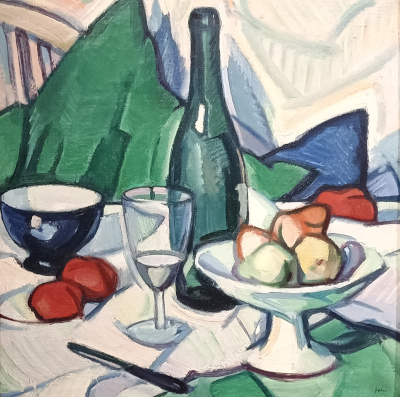
Above: S J Peploe, Still Life with Bottle, oil on canvas, 1912
The building used to be public baths, built in 1885 and the first of the kind in Edinburgh. It's beautiful inside and the tapestry studio is where the original swimming pool sat :
Below: The viewing gallery, looking down on the tapestry artists.
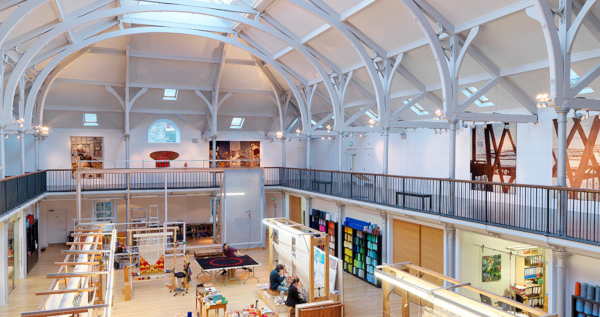
I'll re-visit the exhibition before it finishes on 26 June 2025. It is well worth another look.
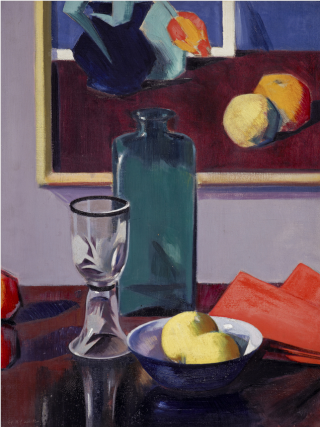
Many art works are not on display in galleries and museums because there is just not enough display space and the collections are large. However, it is still frustrating to see how many are out of sight.
One work I came across is an example: The Green Bottle by the Scottish Colourist Francis Campbell Boileau Cadell. I saw this for the first time recently and liked it a lot, but had never seen it before. Looking it up, I discovered where it was and was disappointed to see that it was "In Storage". A shame because it's a great painting. At least it is in the National Gallery of Scotland, so I might get a chance to see it in person sometime.
This one joins many other works out of sight, including works by other Scottish artists like S.J. Peploe and Leslie Hunter.

Speaking of Edward Gorey, I came across two things about him a day or so after posting about the "tribute" exhibition in Leith.
One was a link on Hacker News about a Comics Journal article by Cynthia Rose about how she had some correspondence with him many years ago. A lovely little story, short and sweet. It shows off more workings of his eccentric mind.
Over time, we discussed a range of topics: the Moors murders, the benefits provided by a ha-ha, Gustave Doré's views about the London slums, Lillian Gish in The Wind, Japanese ghost behaviour in the Edo era, spirit photography, London's cheap bookstores, Rudolf Nureyev's feet, illicit dissections and why green wallpaper had killed Victorians.
I'd never heard of a "ha-ha" until I came across it in Ian McEwen's book Atonement. It is : "a ditch with a wall on its inner side below ground level, forming a boundary to a park or garden without interrupting the view".
The other Gorey reference was seeing that he had done the covers for two books by the writer of "strange" stories, Robert Aickman. I've read some Aickman (and will read some more) and his subtle and odd (sometimes unsettling) stories seem to be a good combination with the artist.
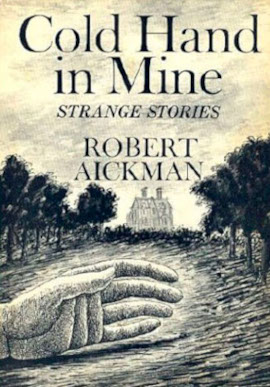
On the right is Gorey's cover for Aickman's collection Cold Hand in Mine. His art also graces Aickman's Painted Devils collection. I have Cold Hand in Mine and it is on my "to be read" list. Unfortunately it is not the one with the Gorey cover.
I found the image of the cover on the blog feuilleton by artist and designer John Coulthart. Some of his artistic interests closely match mine.
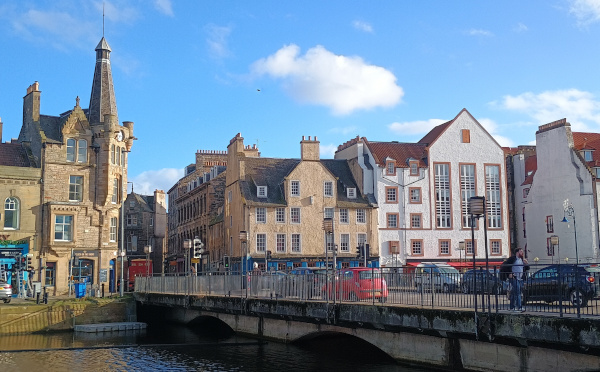
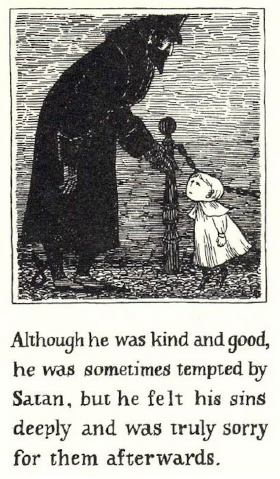
Edward Gorey was an American artist/illustrator famed for his quirky, gothic and somewhat macabre drawings. In his centenary year (he was born in 1925, died in 2000), the Customs House in Leith was the venue for a small exhibition of works by artists paying him tribute.
Above: A view of The Shore in Leith from the Customs House. A blue sky in February.
Right: From the Pious Infant by Edward Gorey.
The art of drawing, illustration and printmaking is such a neglected field that it was great to have a show like this. I think most cities could really do with a dedicated gallery for the graphic arts, Edinburgh included.
Thanks to Paper Galaxy (Linda Hughes) and everyone else involved for taking the time to curate and put this together.
The exhibition was called Phantasmagorey.
The The Gashlycrumb Tinies is a great example of Gorey's work and black humour: an "ABCD" book of weird and wonderful situations ... and untimely deaths. The "tinies" come to unforunate ends.
Below: From the The Gashlycrumb Tinies (1963). This illustration is taken from the Gorey page at Lambiek.
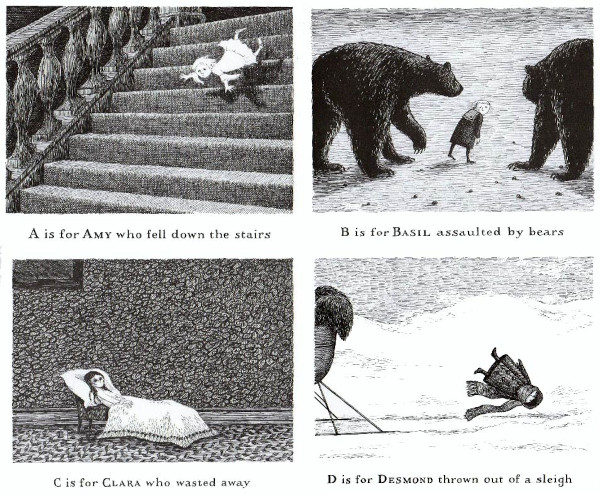
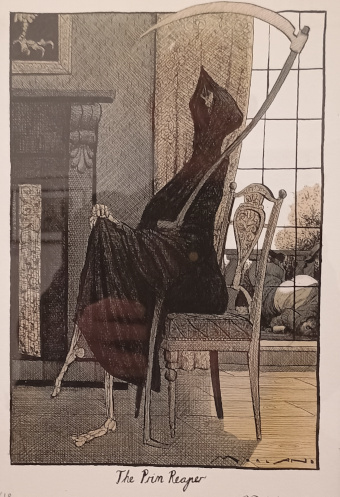
Almost all the art at Phantasmagorey was by artists paying Gorey tribute, including a few I know such as Kate Charlesworth (who lives in Leith apparently), Tom Gauld and Steven Appleby. As you would expect, many pieces were quirky or macabre as well.
Right: The Prim Reaper by Morten Morland
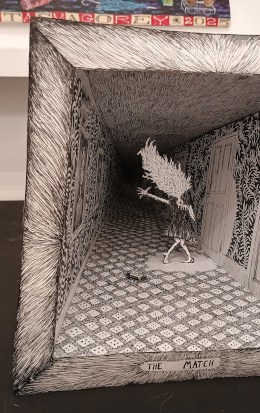
Right: The Match by Ray Baker. A great "Pen on Paper" construction.
Below: I didn't catch the creator of this. Gorey loved making up strange animals.
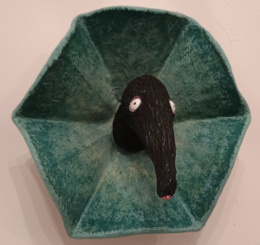
I visited the National Gallery of Scotland in the first week of 2025 to have a look at the Turner watercolours, shown once a year in January. I do this every year.
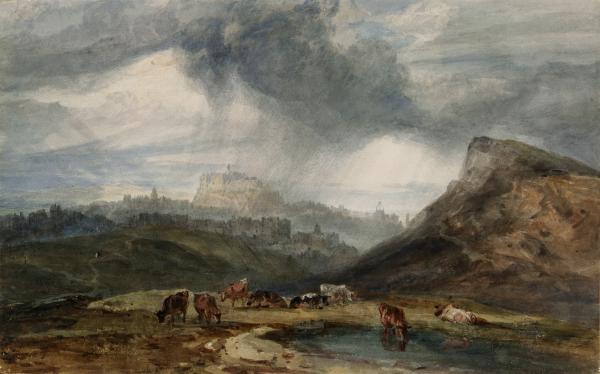 Above:Edinburgh from below Arthur's Seat,Joseph Mallord William Turner,1801,National Gallery of Ireland
Above:Edinburgh from below Arthur's Seat,Joseph Mallord William Turner,1801,National Gallery of Ireland
I am now very glad I went early, because the week after there was a big queue to get in, and earlier this week (Thursday 10am), another even longer queue. I have never seen queues before: snaking out the front door and up the side of the gallery building.
A reason might be that the exhibition was of the Vaughan Bequest from the National Gallery of Ireland this year for the first time. Maybe a good enough reason itself, or maybe good marketing, advertising or an "influencer" somewhere. They are such good paintings that I am just glad I managed to have a look.
From the National Gallery of Scotland site :
In 2025 the National Galleries of Scotland will commemorate the 250th birthday of beloved British artist JMW Turner with a once-in-a-lifetime, free exhibition. For the first time, visitors will be able to marvel at over 30 Turner watercolours from Dublin.
I over-heard a gallery assistant saying that Dublin has not got queues like this.

Good news everybody ...
I've been very angry about the Economist App performance this year, particularly how much it was crashing. I was having to do a factory reset on my tablet every 8 weeks to get a decent experience reading the magazine on my tablet. I am very pleased to say that things seem to have significantly improved however.
There was an update sometime in early November I think and since then it feels a little more responsive and also much more stable. So far, I have really noticed it behaving better. Now the ratings and comments I see on the Play Store are still quite bad but, for me, it seems like the update has fixed the biggest issues I had. I'm still cautious of course, but I am happy to report this. I should rate and comment about this on the "store" sometime soon as well.
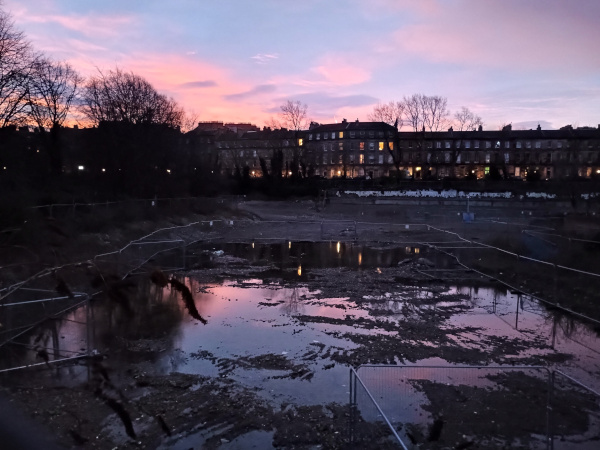
This is the site of the former Royal Bank of Scotland building on Dundas Street in Edinburgh. A huge building, it was demolished recently and now sits empty beside King George V park. The development has hit a snag.
The original plans have changed and the developers are after new permissions from the council. The work is expected to include a lot of new student accomodation of the sort that has been put up throughout the city. Also a lot of rental, residential and a bit of office. There is a lot of pressure on housing: the amount available is insufficient and the costs are high and rising, but I have mixed feeling about this for a variety of reasons. Let's see what happens ...
More information is on the Spurtle.

There's a great article in The Atlantic called The Crumbling Foundation of America’s Military. It is a very sobering look at how far the war fighting capability of the USA has shrunk over the last thirty years. The war in Ukraine has put this into very sharp focus.
It turns out that a lot of America's industrial production of things like 155mm howitzer shells (see right) is via a process almost unchanged for a hundred years. Slow and expensive. The article notes that when Russia invaded Ukraine :
At that time, the U.S. was manufacturing about 14,000 shells a month. By 2023, the Ukrainians were firing as many as 8,000 shells a day. It has taken two years and billions of dollars for the U.S. to ramp up production to 40,000 shells a month—still well short of Ukraine’s needs.
There is a huge amount of dysfunction, inefficiency and cost involved throughout the supply chain. The USA is having to seriously consider a future conflict with a "peer" adversary, not armies like Iraq or the Taliban. They can produce technically advanced weaponry but at massive cost: the Houthi's launch drones that cost a few thousand dollars each. Tomahawks that are fired to intercept these are expensive :
When American ships began striking Houthi targets in Yemen in January, they fired more Tomahawks on the first day than were purchased in all of last year.
How inefficient and sclerotic is the industry? This was a painful read :
One of the most famous examples of this dynamic was an unmanned aircraft invented by the Israeli aerospace engineer Abe Karem originally called Albatross, then Amber, and finally the GNAT-750. He won a Pentagon contract in the 1980s to design something better than the drone prototype offered by Lockheed Martin, known as the Aquila. And he delivered, building a machine that cost far less, required just three operators instead of 30, and could stay aloft much longer than the Aquila could. Everyone was impressed. But his prototype vanished into the valley of death. Although it was a better drone, Aquila looked good enough, and Lockheed Martin was a familiar quantity. But Aquila didn’t work out. Neither did alternatives, including the Condor, from another of the Big Five, Boeing. Only after years of expensive trial and error was Karem’s idea resurrected. It became the Predator, the first hugely successful military drone. By then, Karem’s company had been absorbed into General Atomics—and Karem lost what would have been his biggest payday.
The Atlantic article is worth reading in its entirety.
It is a new and very dangerous world, much easier and cheaper to sow destruction and hard to defend against. The best thing we can all do is to avoid going to war, not at all costs, but certainly make extra effort not to. Wars have a habit of going in very different directions than the one we expect. I have just been listening to the brilliant podcast The Rest is History and their talks on the diplomatic failures that lead to the First World War. We need to learn from history and be much cleverer in how we deal with threats. We can't afford not to.
It is that time of year again, and the Open Eye Gallery opens its 2024 Small Scale show.
Selected artists are invited to submit works in any medium, unframed, with the only restriction limiting the dimensions to 15 x 21 cm, the classic ‘postcard’ size.
Small pictures usually reasonably priced. Lots of good ones from good artists.
Below:
Left: Nestled off the Loch by Megan Burns, Acrylic on board, 15x21cm [link]
Right: Full Moon Afternoon by James Tweedie RGI, Acrylic on card, 15x21cm [link]
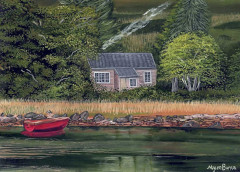
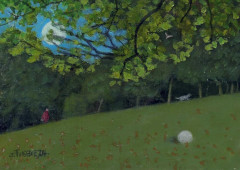
Below:
Left: Patience by Clare Mackie, Acrylic on canvas, 15x21cm [link].
Right: A Squirrel for Mary by Tracey Johnston, Acrylic on board. 15x21cm [link].
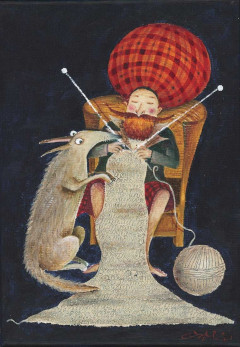
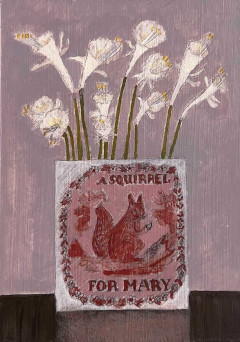
Most of the paintings are priced £200 to £600 but there are one or two priced much higher. I'm not sure why. Have a look and see what you think. The show is online only.
I visited the Burrell for the first time a few weeks ago. I've been meaning to visit for years.
The main reason to go was a look at the Degas exhibition before it closed. Being a huge admirer of the works of the great French artist, the exhibition was the big push I needed to get over there. I took the bus for a change, then a short (two stop) train journey from Glasgow Central (to Pollokshaws West), a short walk through the lovely park and arriving at the newly refurbished and fixed Collection building. It's been closed for a few years to have its roof fixed.
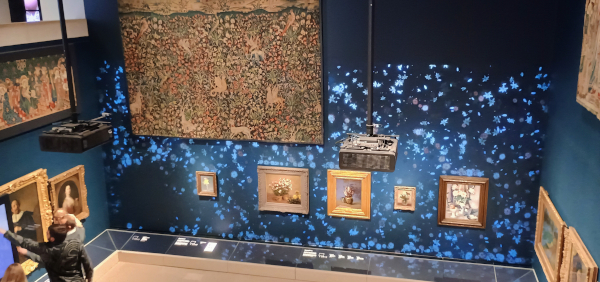 Above: One of the Burrell's display rooms.
Above: One of the Burrell's display rooms.
What can we say about Degas? He's usually classed as an "Impressionist", having exhibited in their exhibitions over the years (from 1874), but his work always differed substantially from the other artists so described (like Monet). He is famous for his portraits of people at work, whether ballet dancers or washer-women. An artist of the city and modern life. He did not paint en plein air as most of the Impressionists did (in fact, he was highly critical of the practice). The Burrell Collection shows how great a draftsman he was: drawings in pencil or pastel, a favourite medium.
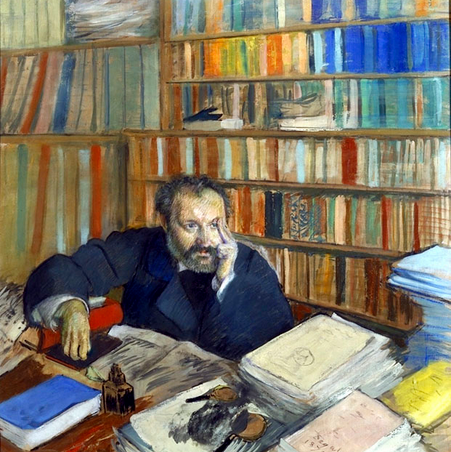
Licensed under a Creative Commons Attribution-NonCommercial 4.0 International License.
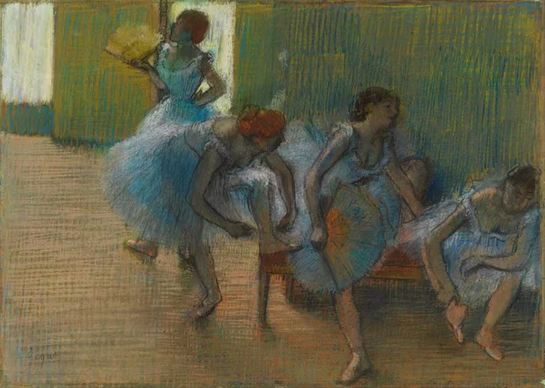
Licensed under a Creative Commons Attribution-NonCommercial 4.0 International License.
I had a look around the rest of the collection of course and it's impressive. A bit like a mini-Victoria and Albert museum, with a collection of furniture, tapestries, carpets, armour and ceramics: amongst many other things. I was lucky on the day, with the sunshine streaming through the windows and showing off some stained glass to good effect. I'll definitely visit again. With this and the Kelvingrove Museum, Glasgow has some great attractions.
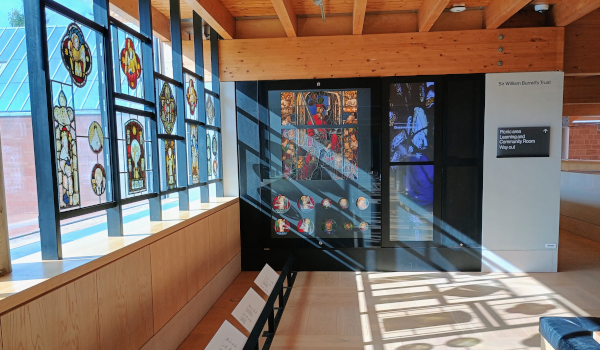
I came across a Publishing Weekly article about book sales recently. It appears that the types of books doing well, and keeping the sales numbers more respectable, are the so-called "Romantasy" books, a neologism that compresses "Romance" and "Fantasy". The cliché would be: romance books with magic included. I also see that Amazon have Romantasy colouring books but I hesitate to draw any conclusions from this.
Authors Sarah J. Maas and Rebecca Yarros are mentioned as being the current big sellers. I think I first heard the term "romantasy" from Stephen E Andrews on his YouTube channel Outlaw Bookseller and now can't help but see these books. His point was that the "Science Fiction" genre is shrinking and the "Fantasy" one grows, and it is all a matter of basic economics. Publishers go where the money is and their budgets are spent there. It's a shame that "science fiction" and "fantasy" are both dumped into the same bucket.
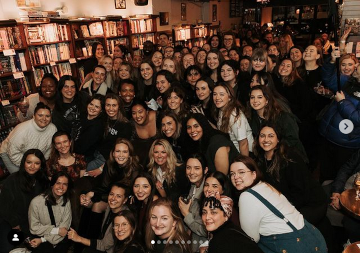
Maas certainly has a lot of momentum behind her, as you can see on the huge list of "midnight release parties" planned for her next book.
On the right: a photograph from her Instagram page of one of her book signings.
According to the article Boys Need Books by Myke Bartlett in The Critic, the publishing industry is majority female now: readers, authors, agents, editors, marketers. No doubt there are many factors at play here: possibly some over-correction of the previous male domination in years gone by. It's not a bad thing per se except how it might result in a different allocation of resources to the detriment of some market segments. A lot of the marketing is social media now of course: we have things like BookTube and BookTok (and I admit to liking a few YouTube "BookTube" channels). Maas has two million Instagram followers. Whatever she and other "Romantasy" authors are doing, it's working. But looking at the photo from her meetup above: where are the boys?
If boys don't read when young it might be difficult to start later. Maybe video games and screen time are an aspect of this but it's also possible that fewer books appeal to a boy nowadays. I'm sure publishers can do better.

On the left: Rebekah Greenway ("Booknuts") shows off her Midjourney and Photoshop skills in the service of Romantasy book characters. This is a picture from her Instagram page.
Midjouney? From their docs page :
Midjourney is an independent research lab exploring new mediums of thought and expanding the imaginative powers of the human species. We are a small self-funded team focused on design, human infrastructure, and AI.
So, there you are. You prompt the computer on what sort of picture you want and the "AI" will generate it and you then iterate on this (I assume). This is called generative AI. I wonder how many of these books are also written by an AI now? That seems a bit of a scary thought to me.
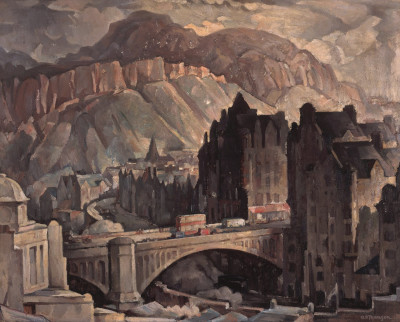
Above:Edinburgh North Bridge and Salisbury Crags, oil
I visited the City Art Centre at the weekend to see their exhibition Adam Bruce Thomson: The Quiet Path. Thomson is a little known Edinburgh artist of the 20th Century.
The "quiet path" is a reference to his unassuming nature and low profile. Thomson (1885-1976) was an Edinburgh born artist and spent almost his entire life in the city, including a long spell teaching at Edinburgh College of Art. The college was formed in its present state (and site) in 1907, and Thomson was a student himself in the early days.
The exhibition is over two floors and shows his flexibility in oil paint, drawing and print making. I was also particularly drawn to some great pastel pictures, colourful and bright.
Adam Bruce Thomson is much less known today than some of his more famous contemporaries and that is a shame. Hopefully this small exhibition raises his profile because he deserves a wider audience.
The exhibition runs at the City Art Centre in Edinburgh until Sunday October 6th 2024 and is free.
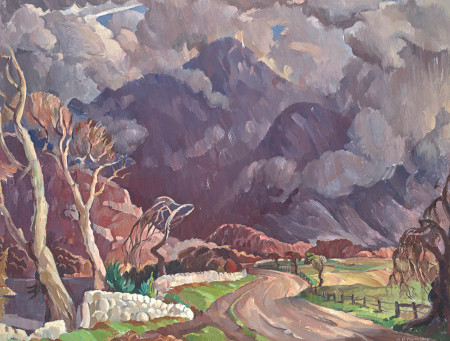
Above:The Road to Ben Cruachan, 1932, oil
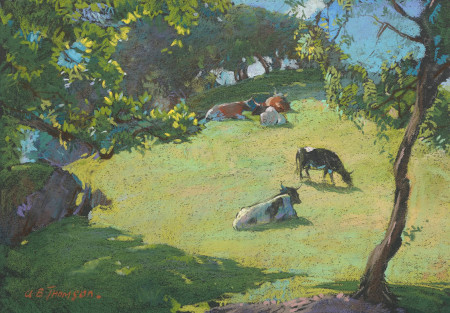
Above:Trees and Cattle, Colvend, 1920's, pastel
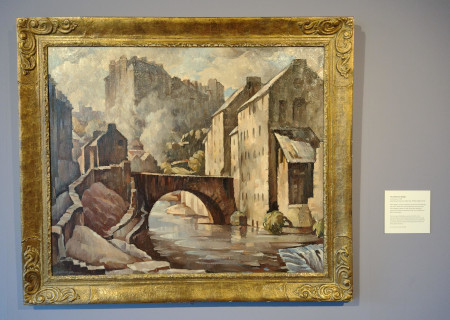
Above:The Old Dean Bridge, 1932, oil
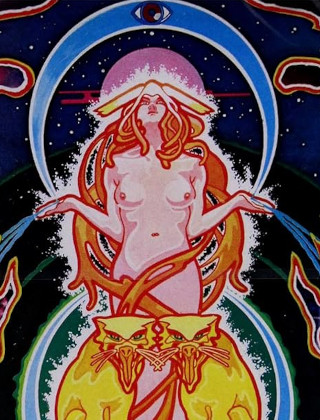
I saw Hawkwind live in concert last weekend. I haven't seen them live in years: decades in fact. Dave Brock is the cornerstone of the band of course and the last remaining original. He might be creaking a bit, but at 82 you have to give him huge respect for keeping things going and doing his bit for psychedelic space-rock. He looked good and played well: I hope I'm as fit as he is when I reach that age.
"Spirit of the Age" from the album Quark, Strangeness and Charm, stood out for me. I don't think I've ever heard it live before. That was a great album and definitely hugely enhanced by Robert Calvert's song writing. Great to hear it live.
I missed out on their last concert up here (their 50th anniversary tour) and was kicking myself for not going. Not even Hawkwind can go on forever but, luckily for me, they don't know when to stop touring. And good luck to them.
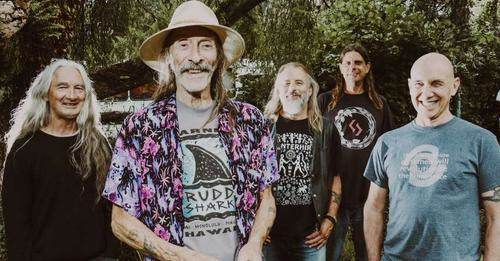

I have factory reset my tablet again yesterday (April 8th). The Economist app has started crashing too much again. How much? It crashed 4-5 times while I was trying to read an article at lunchtime: I'd restart the app (with all the delays that involves), go back into the article (more delay) and then maybe get 10 secs and then a crash again. Repeat. I gave up that article. As I detailed before, I'm back in the same hole.
My last factory reset was back in February 2024 :
2024-02-07 --- factory reset .. 2024-03-09 --- crash 2024-03-13 --- crash - then crashes on 16,25,27 2024-03-29 --- x2 crash - then once each day .. 2024-04-06 --- x3 2024-04-07 --- x4 2024-04-08 --- x5+
So it looks like I get about 4 weeks of decent behaviour but then a slowly degrading experience for the next few weeks. I'll see how this reset goes. Would I carry on paying for this? Maybe, assuming the discount I got. But it is wearing thin. I'll have to decide in September.
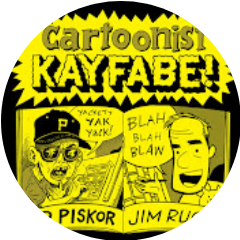
Like many people, I was shocked earlier in the week to read about the accusations against Ed Piskor, comic book creator and half of the Cartoonist Kayfabe YouTube channel. But it was just terrible to see that he then killed himself two days later. Just absolutely appalling. I am still trying to process it. Ed and his channel co-host Jim Rugg have been constant companions to me over the last few years: I've watched and listened to the channel very regularly, particularly when I paint. They started as pandemic lockdown companions. Ed loved comics: their creation, the artistic process, techniques involved, the business, the history, everything. An infectious enthusiasm.
I have to say that my heart goes out to his family first and foremost. Also to Jim Rugg, the other half of the channel, who must be devastated over the turn of events this week. What a tragedy this has been. I'll miss Ed a lot.
The Lambiek folks have an overview of his life, work and death. Also, the Comics Journal.
What a terrible week.
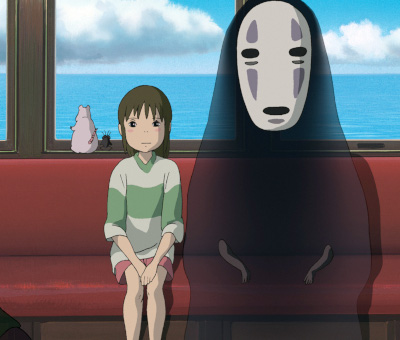
Now for some more Japanese culture, this time animation, also known as anime.
The most famous Japanese anime studio is Studio Ghibli, a company I've come across many times but never seen any of their films. A lot of people really love the stuff they make. As I've said, I've never had much interest in manga, or anime, but I've been been intrigued enough now that I decided I should should watch one. I recently saw Spirited Away, one of their most popular productions (and also a 2003 Oscar winner).
It's a simple story about a young girl separated from her parents and trapped in a ghostly world of spirits, complete with magical people, weird entities and strange creatures. The world appears centered on a large bath-house run by a witch and the little girl has to find a job and work out how to escape and save her family.
Well, I really loved the film, enjoying it immensely. Charming and beautifully made "cell" animation, I can see why the the Ghibli "style" is such a worldwide success. There's a bit of a "signature" style, a traditional animation look alongside atmospheric painted backgrounds. I can understand a film like this being a big hit for both children and adults. Funny moments but also themes that tug at the core human emotions of love, loneliness and loyalty. It's also a refreshing change to see a film informed by Japanese cultural traditions even though it speaks to universal traits.
A film easy for me to recommend wholeheartedly. I will try and watch another Studio Ghibli production.

I recently wrote about my poor experience with The Economist android app. Well, since a factory reset, I'm happy that things have improved immensely. It is still somewhat slow and unresponsive, but the main problem I had was the crashing, and this has (mostly) stopped.
I did the reset on February 7th. I got my first app crash on March 9th, so got about four weeks of relatively pain free reading. Since then, I've had two crashes in the past week, so possibly a sign things are degrading a bit again. The app is still a bit slow and annoying sometimes but at least I now get a chance to read the articles. And this makes a huge difference. I'll see how it goes over the next week or so. This level of performance is just about "good enough" for me.

Above: library problems. Photo: Christine Ro (via BBC web site)
I recently wrote about ransomware and paid some attention to the British Library's current problem with this scourge. Well, a BBC article (Why some cyber-attacks hit harder than others) returns to the scene and covers the continuing issues and costs being borne. It's a sorry state of affairs. Looks like people are having to order books with paper forms and the digital media is still offline.
The Russian hacker group Rhysida claimed responsibility, and demanded a ransom of 20 bitcoin (equivalent to £600,000 at the time). After the British Library refused to pay up, and following an online auction of stolen data, the hackers leaked the nearly 600 GB of private information on the dark web.
Of course, Russia. The country has long been a center of criminal "hacking", state sponsored and private enterprise. Russian authorities look the other way as long as these groups don't attack Russia itself; maybe the state will co-opt or sponsor the activity. China is another major offender. The New York Times via the archive site:
Leaked Files Show the Secret World of China’s Hackers for Hire
The Chinese government’s use of private contractors to hack on its behalf borrows from the tactics of Iran and Russia, which for years have turned to nongovernmental entities to go after commercial and official targets. Although the scattershot approach to state espionage can be more effective, it has also proved harder to control. Some Chinese contractors have used malware to extort ransoms from private companies, even while working for China’s spy agency.
The problem we have is that computer and network security is hard. As well as the actual "technical" mitigations we can use (e.g. spam filters, firewalls), people themselves are usually a weak link. Anyone can be misdirected or scammed, even "experts". And almost everything is connected to the internet today, including everything that keeps civilisation actually "civilised" and people alive. Let's hope things don't get worse. And to be clear, I don't think ransoms should be paid because it just encourages these attacks.

My tablet has taken to telling me something I am painfully aware of. The Economist android app crashes. A lot. In fact, it crashed over ten times for me at lunchtime yesterday. Given that it is also very slow, it takes a long time to start it up and get to a point I can attempt to read something again (it also loses the current article). It might crash again before I even get to the article again, if I can find it (it sometimes rearranges the home page and hides stuff). This is the way it is every day now.
I like The Economist magazine in general and have been a subscriber for many years now. I still find the writing good and explanations of current affairs and business excellent, even if I am a bit less aligned with it on some issues than I used to be. However, given the problems reading it, I will not extend my subscription again later this year.
I am also far from the only one having a problem. If you head over to the Google Play Store and look up the Economist App, you will see many people saying very similar things. This needs to be addressed or people will stop buying it. Fundamentally, what do we have here? A collection of text and images on pages wrapped in a "magazine". How hard is this? It is a solved problem.
I read on a Samsung Galaxy Tab A, from 2018. It has 3 GB RAM and 32GB storage. I use it only for the Economist app now. I see no reason why the Economist app should not work on this. If they really need to stretch the limits of what this tablet supports (but why?), give us a "lite" version. I refuse to buy another tablet just to read a "magazine".
I have tried a factory reset of the tablet. Things improved for a few days but started getting bad again soon after.
Here are some of the things wrong :
- The app is very slow and often unresponsive.
It is hard to tell if you've "clicked" the link and have to retry a lot. Finally, after a 10 second wait, maybe it will work. - The app crashes a lot (see above).
- The app "resets" itself to the home screen.
It rarely remembers your place in an article so you have to find it yourself, which is slow. - The downloaded issue has the same problems.
I've stopped trying to go through the "weekly" edition because it is even slower to get into. Even having supposedly "downloaded" it, you would not know. Everything behaves the same and a constant appearance of needing to download or refresh content. It's not just the ads.
- The "weekly" page usually shows me the wrong (previous) week. Selecting "Browse Editions" might refresh (slowly) and show all the available editions but does not let me select the new edition: it shows me the previous one again.
So, I have just about had enough. My subscription is good until the autumn but I will not pay money again for this horrible, frustrating experience. I will call their help center and let them know. I'd like my money back.

An Update
I've just done another factory reset, reinstalled the app from thePlay Store and logged in. I used it at lunchtime and, although the app was a bit slow and unresponsive to "clicks", it behaved better. It didn't crash once, which is the most important thing to me. I actually managed to read a few articles and not feel angry or frustrated at the end of my lunchtime. I'll see how it goes for the next few days.



